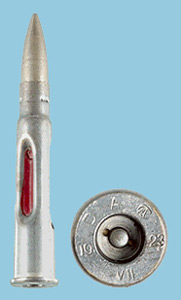Home | Glossary | Resources | Help | Contact Us | Course Map
Archival Notice
This is an archive page that is no longer being updated. It may contain outdated information and links may no longer function as originally intended.
Autoloading Pistols
Based on findings from the preliminary examination, proceed with the examination of autoloading pistols as follows:
- Determine the magazine capacity.
- Load the magazine to capacity using dummy cartridges.
- When no more dummy cartridges can be inserted into the magazine, the magazine should be placed into the firearm to ensure it will catch and function in the firearm.
- If the magazine inserts and functions properly, the dummy cartridges should be removed, counted, and magazine capacity recorded.
- Cycle the action by pulling the slide to the rear and determine if a slide stop is present.
- If present, lock slide to the rear; examine the extractor and ejector.
- If not present, manually hold the slide to the rear; examine the extractor and ejector.
- Determine if the firearm is capable of full automatic fire.
Note: A firearm may be capable of full automatic fire by original design or later modification. Modifications often have no selector switch or externally visible indication. - Determine if a selector switch is present.
- If a factory authorized selector switch is present, the firearm may be capable of full automatic fire by design. In this case use the full automatic fire by design test protocol that follows.
- If no selector switch present, proceed with the steps below.
- Cock the firing mechanism.
- Pull the trigger and keep it pulled rearward
- Holding the trigger to the rear, pull the slide to the rear and release the slide.
- Release the trigger
- Pull the trigger to the rear to release the firing mechanism; if the firing mechanism has already been released, then the firearm did not disconnect and it fired in full automatic mode when the slide was manipulated in step 3.
- Determine if a selector switch is present.
- Test the trigger pull. Click to view trigger pull section.
- Test the safety functions. Click to view safety section.
- Test fire the firearm. Click to view test fire section.
Additional step, if capable of full automatic fire by design test protocol- Perform full automatic functionality test according to laboratory protocols.
- Determine automatic fire functionality.
- Insert a minimum of three cartridges into the magazine.
- Pull and hold the trigger to the rear; all three cartridges should fire.
- Confirm automatic fire functionality.
- Load a number of cartridges into the magazine.
- Fire a short burst of full automatic fire and release the trigger
- If the firearm stops firing, it is functioning properly as a full automatic firearm.
- If the firearm does not stop firing, it is not functioning properly (determination should be made of the cause of the malfunction).
- Determine automatic fire functionality.
- Perform full automatic functionality test according to laboratory protocols.
Additional step, if capable of full automatic fire by modification test protocol:
- Perform full automatic functionality test according to laboratory protocols.
- Determine automatic fire functionality.
- Insert a minimum of three cartridges into the magazine.
- Pull and hold the trigger to the rear; all three cartridges should fire.
- Disassemble, examine, and document modifications.
- Determine automatic fire functionality.
See the YouTube Terms of Service and Google Privacy Policy
Additional Online Courses
- What Every First Responding Officer Should Know About DNA Evidence
- Collecting DNA Evidence at Property Crime Scenes
- DNA – A Prosecutor’s Practice Notebook
- Crime Scene and DNA Basics
- Laboratory Safety Programs
- DNA Amplification
- Population Genetics and Statistics
- Non-STR DNA Markers: SNPs, Y-STRs, LCN and mtDNA
- Firearms Examiner Training
- Forensic DNA Education for Law Enforcement Decisionmakers
- What Every Investigator and Evidence Technician Should Know About DNA Evidence
- Principles of Forensic DNA for Officers of the Court
- Law 101: Legal Guide for the Forensic Expert
- Laboratory Orientation and Testing of Body Fluids and Tissues
- DNA Extraction and Quantitation
- STR Data Analysis and Interpretation
- Communication Skills, Report Writing, and Courtroom Testimony
- Español for Law Enforcement
- Amplified DNA Product Separation for Forensic Analysts


